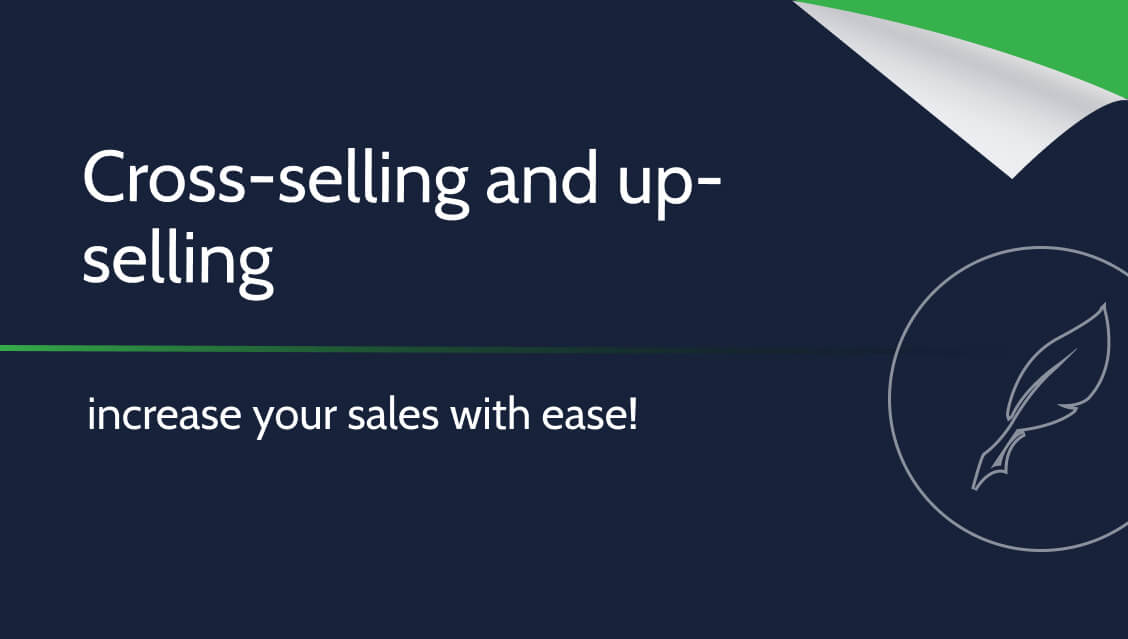Cross-selling and up-selling – increase your sales with ease!

The main goal of marketing strategies is to increase sales by satisfying the conscious, unconscious or artificially created needs of the customer. Cross-selling and up-selling allow you to increase your order portfolio by offering better and additional products.
What is cross-selling?
Cross selling is the art of offering complementary products to the customer.
The purpose of this technique is to draw customers attention to products that s/he may need but have forgotten about. It could happen that the consumer would be forced to purchase them at a later date, so it is good practice to suggest that s/he buy something additional related to the selected product that may be useful to him in the future.
Thanks to this, the customer will likely buy them from the advertiser, instead of from the competition, thereby increasing the advertiser’s revenue.
For example a customer who buys a battery-powered toy may not know that the package does not include a power source. In the future, he will have to buy batteries to activate the purchased toy, so it is worth offering him this product at the stage of completing the order.
Cross-selling is a safe marketing strategy because, in the worst case scenario, the customer will refuse to buy additional products and will stop at what he wanted to buy. However, offering complementary goods too intrusively may make the customer feel bad and, as a result, he may switch to the competition. Therefore, you should exercise moderation and limit yourself to two or three additional products.
The use of cross-selling
Cross-selling is widely used in sales practice and has been bringing tangible benefits for many years.
The McDonalds restaurant chain earns an extra $200 million a year thanks to the famous “how about fries with that?” question.
There are several typical cross-selling solutions that are used very often, even intuitively. Examples here could be:
- Other customers also bought… – such a formula is becoming more and more common under a product purchased online. It presents product combinations developed based on previous customers’ purchases. If someone has already bought such a set, there is a good chance that another customer will also be interested in such a combination.
- Cheaper in a set – offering a set of complementary products at a lower price will make the customer more willing to buy all the equipment at once in your store. An additional advantage of this solution is the selection of appropriate products for the set, so the customer does not have to wonder how to match the purchased elements (e.g. what batteries will be needed for a given device).
- Free shipping on purchases over… – By offering discounts for larger purchases, the customer is encouraged to select additional products. This is an important factor in increasing the effectiveness of cross-selling.
- Not only products! — cross-selling does not have to apply only to complementary products. Instead, we can also offer the client a specific service, for example installation of purchased household appliances or the first launch and formatting of an electronic device.
Cross-selling in SEO texts
This marketing strategy can also be found in SEO texts. In particular, information and links to complementary articles can be included in the description of a given product or category. The description of the offer, however, may mention subsequent services that are used together in order to create the impression of a complete offer (e.g. from design, through production, to transport and assembly at the destination).
Internal linking should often be to complementary products to best utilize its potential.
What is upselling?
Up-selling is a more difficult marketing strategy, requiring sensitivity and skill. It involves offering the customer a higher-end, and therefore more expensive, product.
However, this process should run smoothly and the price differences between the subsequent models offered should not be too large. The seller must also sense to what extent the buyer will be interested in higher-end products. If a customer buys a laptop from a store, for instance, the seller can then, after a short while, offer the customer a different notebook model that has better RAM and costs only a few thousand naira more. The buyer may be tempted by the better properties of the device and buy a more expensive product.
Poorly conducted up-selling may lead to the customer feeling cheated and leaving the store without making any purchase. Therefore, you should use this marketing strategy carefully.
The use of up-selling
Like cross-selling, up-selling has found wide application in practice. There are also a few tricks based on this.
The decoy effect is the addition of a third, unattractive option in a sale to increase the attractiveness of another. An example is coffee: let’s say you’re selling a small container of coffee for N800 and a large one for N1,400. After adding a medium coffee, costing N1,200, customers will be tempted to reach for the large one, which is only N200 more expensive than the medium one.
Typical examples of the use of up-selling are:
- Store advisor – his task is often to convince the customer that better equipment will be more useful to him in the long run.
- Promotions on high-end products – a price reduction can encourage a customer to buy a better product so that they can save on it (compared to the price without the discount).
- Enlarged set – enlarged fries or a larger drink are typical examples of up-selling in restaurants.
- Also services – in addition to products, you can also sell services using an up-selling strategy. An example would be internet speed. Often, the customer is offered a faster connection for a small additional fee.
Up-selling in SEO texts
Up-selling in SEO texts is not easy because product descriptions are aimed at many customers. However, it is always worth showing a few arguments for buying a higher-end product. These should be simple benefits so that the customer doesn’t start to think too hard. Then they may give up the purchase and look for a more suitable device on other websites.
Differences between cross-selling and up-selling
Najważniejszą różnicą między cross-sellingiem, a up-sellingiem jest rodzaj proponowanych przez sprzedawcę produktów lub usług. W pierwszym przypadku są to dobra komplementarne, które uzupełniają koszyk zakupów. W drugim natomiast będzie to produkt z wyższej półki, posiadający większą cenę i lepsze parametry. W obu przypadkach jednak chcemy zachęcić klienta do zwiększenia portfela zamówień.
The most important difference between cross-selling and up-selling is the type of products or services proposed by the seller. In the first case, these are complementary goods that complement the shopping basket. In the second case, products will be a higher-end product, with a higher price and better parameters. In both cases, however, all the advertiser wants to do is to encourage the customer to increase their order portfolio.
What to watch out for in marketing strategies?
When using marketing strategies, we should always make sure that our actions are subtle and delicate. Otherwise, the customer may feel lost or cheated, which will not have a positive impact on building a lasting relationship with them.
In any case, you need to exercise moderation. In cross-selling, it is worth limiting the value of additional services and products to 20% of the price of the main product. Above this value, the customer will treat the proposed products as a new purchase. Also in the case of up-selling, the price difference should be small to encourage the customer to make a purchase.
Summary
- Cross-selling means offering products that are complementary to those already purchased.
- Up-selling involves offering a higher-end product to the customer.
- The above marketing strategies are often used in practice to increase sales.
- When using up-selling and cross-selling, remember to be careful so as not to discourage the customer from shopping in your store.
- The most important difference in these marketing activities is the type of products or services proposed by the seller.

















Comments
The article provides invaluable information about Cross Selling/Up Selling, making it a great resource for freelancers and businesses considering investment in this aspect of their operations. Keep up the good work!